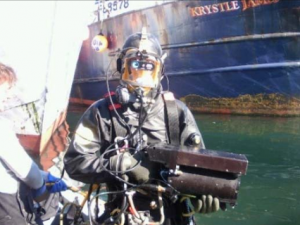 Project Summary:
Project Summary:
During construction of the NBMCT, many activities (including dredging) may have a temporary detrimental effect to the fish that may be present within New Bedford Harbor. A Fish Monitoring Workgroup (including members from NMFS, EPA and Mass DMF) was convened to prepare a Fish Deterrent Plan that could be utilized to reduce the impact to fish by excluding them from a proposed area. The input from the Fish Monitoring Workgroup was incorporated into a Fish Deterrent Plan. This Fish Deterrent Plan (FDP) included all measures to be taken that decreased the chance of mortality to marine species of concern and their spawning activities (where applicable), including: Atlantic sturgeon,
Winter and Windowpane Flounders, Scup, and Anadromous fish species as directed by the National Marine Fisheries Service (NMFS).
Scope of Work:
Fathom Resources (Fathom) performed weekly monitoring of installed fish exclusion devices (silt curtains and bubble curtains). Monitoring was first implemented one day after the initial fish exclusion efforts are undertaken and once a week thereafter. Surveys were performed with a sonar fish finder and a towed video system. The perimeter of the area will be surveyed twice. First to verify the silt curtain and bubble curtains were in place and second to verify the associated weir leader net was in place). Then the dredge area was surveyed to determine if fish were present using the following procedures:
- Transects were run parallel to shore or depth contours with a randomly selected start point for each survey. The survey area was approximately 1200 feet in length and ran parallel to shore. The surveys were run at approximately 1 nautical mile per hour. Transects were spaced 100’ on center and began 50’ from the eastern boundary of the Silt Curtain.
- Two methods for detecting fish were utilized. A standard fish finder for pelagic fish schools and video surveillance for flat fish, and a video method for detecting flat fish. In order to ensure that visibility is acceptable for the survey, the Fathom used a laser scaling method at each transect that visually confirmed the seafloor.
- If a transect failed the visibility test, Fathom would select up to 5 additional grids to transect.
- If more than 5 transects fail the visibility test, then Fathom divers completed the survey.
A video monitoring report was provided to the Fish Monitoring Workgroup weekly within 4 days of the monitoring. For every video monitoring event the report described:
- The condition of the engineered barriers (silt curtain, bubble curtains, and weir leader net); The prevalence of flatfish and other fish at the base of the fish exclusion devices;
- Any actions taken to improve the conditions of the fish exclusion devices;
- The total count of grid/transects completed;
- The total count of grid transects skipped due to visibility – if grid survey method used;
- Description of any survey alterations due to lack of visibility;
- Total count of flatfish encountered;
- Total count of other fish encountered;
- Total count of schools on the sonar record;
- Description of any actions taken to scare fish from the area;
- Any turbidity monitoring exceedances;
- Recommendations to improve the survey methodology, the fish exclusion devices, or the fish scare tactics.
